Gaming's Psychological Impact on Malaysian Adolescents: A Proposal
VerifiedAdded on 2023/06/11
|30
|7692
|93
Project
AI Summary
This project proposal investigates the impact of gaming on the psychological behavior and health of adolescents in Malaysia. It addresses research questions related to the effects of gaming on mental health, socialization, and deviant behavior, considering gender differences and potential interventions. The proposal includes a literature review covering addiction, self-regulation, depression, aggression, and health issues related to gaming, as well as gamification, parenting control, entertainment value, and economic aspects. The research methodology outlines the theoretical framework, sampling plan, data collection methods, and limitations. The study aims to fill the knowledge gap regarding digital games and their effects on psychological behavior and social health among young people in Malaysia, providing insights for addressing gaming disorders and promoting positive gaming experiences. Desklib provides access to similar project proposals and solved assignments for students.
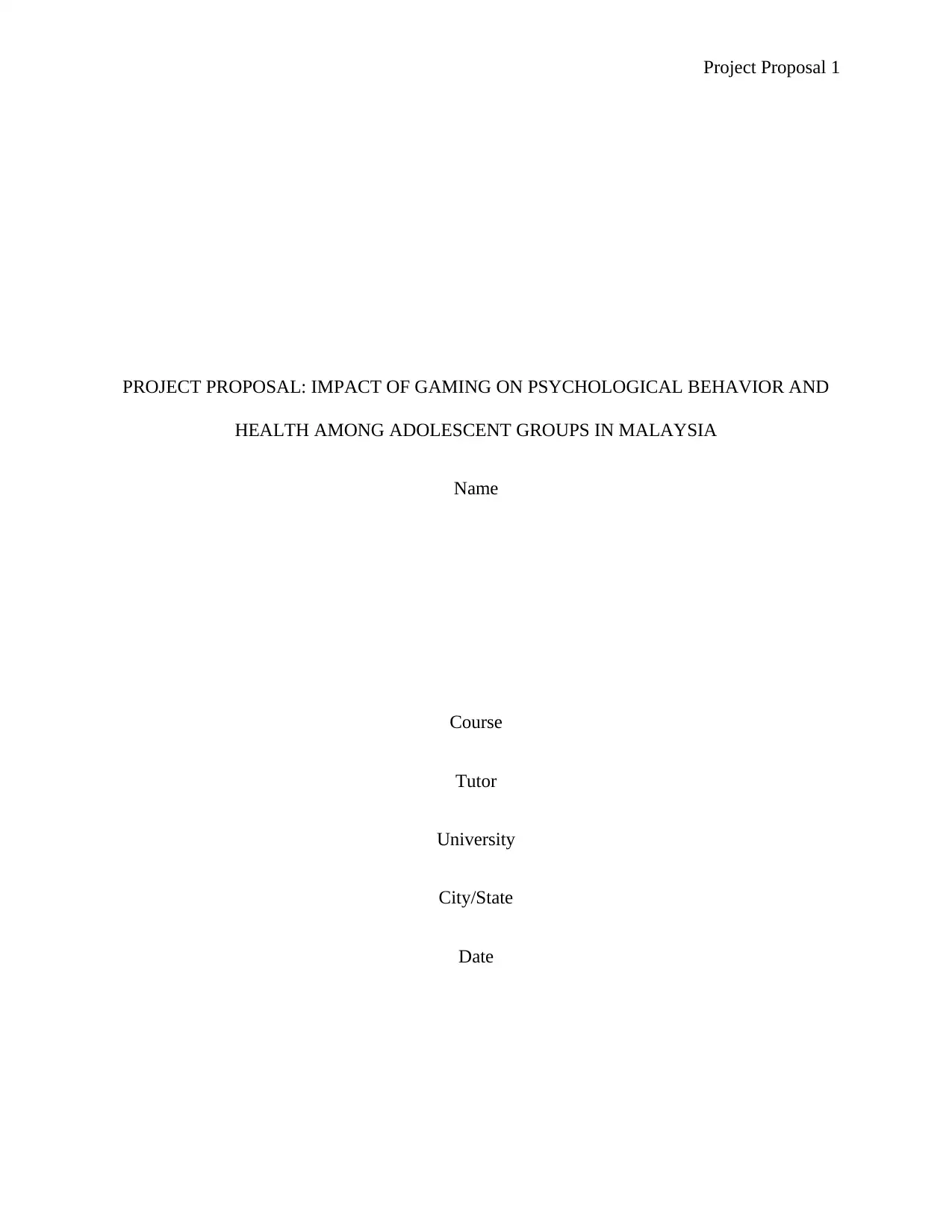
Project Proposal 1
PROJECT PROPOSAL: IMPACT OF GAMING ON PSYCHOLOGICAL BEHAVIOR AND
HEALTH AMONG ADOLESCENT GROUPS IN MALAYSIA
Name
Course
Tutor
University
City/State
Date
PROJECT PROPOSAL: IMPACT OF GAMING ON PSYCHOLOGICAL BEHAVIOR AND
HEALTH AMONG ADOLESCENT GROUPS IN MALAYSIA
Name
Course
Tutor
University
City/State
Date
Paraphrase This Document
Need a fresh take? Get an instant paraphrase of this document with our AI Paraphraser
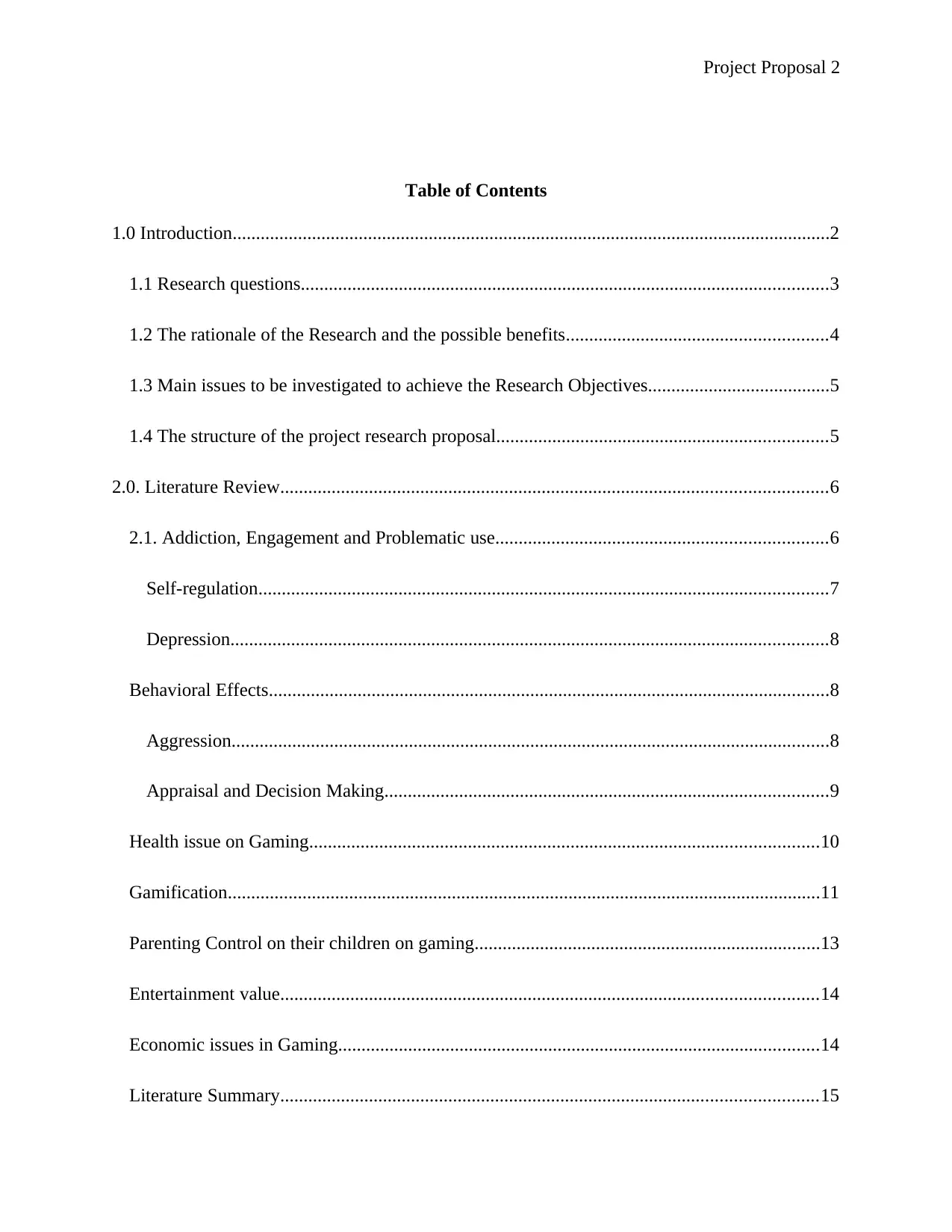
Project Proposal 2
Table of Contents
1.0 Introduction................................................................................................................................2
1.1 Research questions.................................................................................................................3
1.2 The rationale of the Research and the possible benefits........................................................4
1.3 Main issues to be investigated to achieve the Research Objectives.......................................5
1.4 The structure of the project research proposal.......................................................................5
2.0. Literature Review.....................................................................................................................6
2.1. Addiction, Engagement and Problematic use.......................................................................6
Self-regulation..........................................................................................................................7
Depression................................................................................................................................8
Behavioral Effects........................................................................................................................8
Aggression................................................................................................................................8
Appraisal and Decision Making...............................................................................................9
Health issue on Gaming.............................................................................................................10
Gamification...............................................................................................................................11
Parenting Control on their children on gaming..........................................................................13
Entertainment value...................................................................................................................14
Economic issues in Gaming.......................................................................................................14
Literature Summary...................................................................................................................15
Table of Contents
1.0 Introduction................................................................................................................................2
1.1 Research questions.................................................................................................................3
1.2 The rationale of the Research and the possible benefits........................................................4
1.3 Main issues to be investigated to achieve the Research Objectives.......................................5
1.4 The structure of the project research proposal.......................................................................5
2.0. Literature Review.....................................................................................................................6
2.1. Addiction, Engagement and Problematic use.......................................................................6
Self-regulation..........................................................................................................................7
Depression................................................................................................................................8
Behavioral Effects........................................................................................................................8
Aggression................................................................................................................................8
Appraisal and Decision Making...............................................................................................9
Health issue on Gaming.............................................................................................................10
Gamification...............................................................................................................................11
Parenting Control on their children on gaming..........................................................................13
Entertainment value...................................................................................................................14
Economic issues in Gaming.......................................................................................................14
Literature Summary...................................................................................................................15
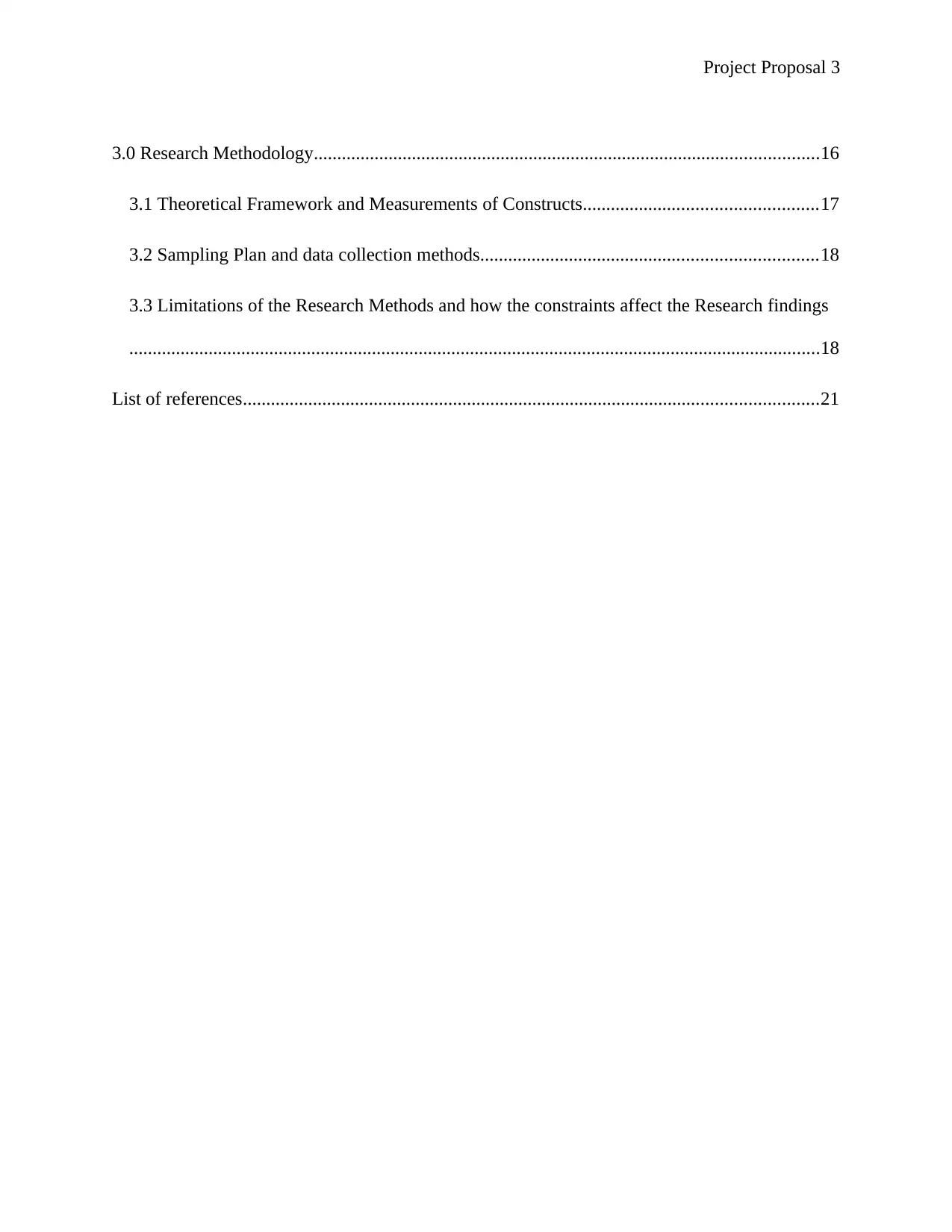
Project Proposal 3
3.0 Research Methodology............................................................................................................16
3.1 Theoretical Framework and Measurements of Constructs..................................................17
3.2 Sampling Plan and data collection methods........................................................................18
3.3 Limitations of the Research Methods and how the constraints affect the Research findings
....................................................................................................................................................18
List of references...........................................................................................................................21
3.0 Research Methodology............................................................................................................16
3.1 Theoretical Framework and Measurements of Constructs..................................................17
3.2 Sampling Plan and data collection methods........................................................................18
3.3 Limitations of the Research Methods and how the constraints affect the Research findings
....................................................................................................................................................18
List of references...........................................................................................................................21
⊘ This is a preview!⊘
Do you want full access?
Subscribe today to unlock all pages.

Trusted by 1+ million students worldwide
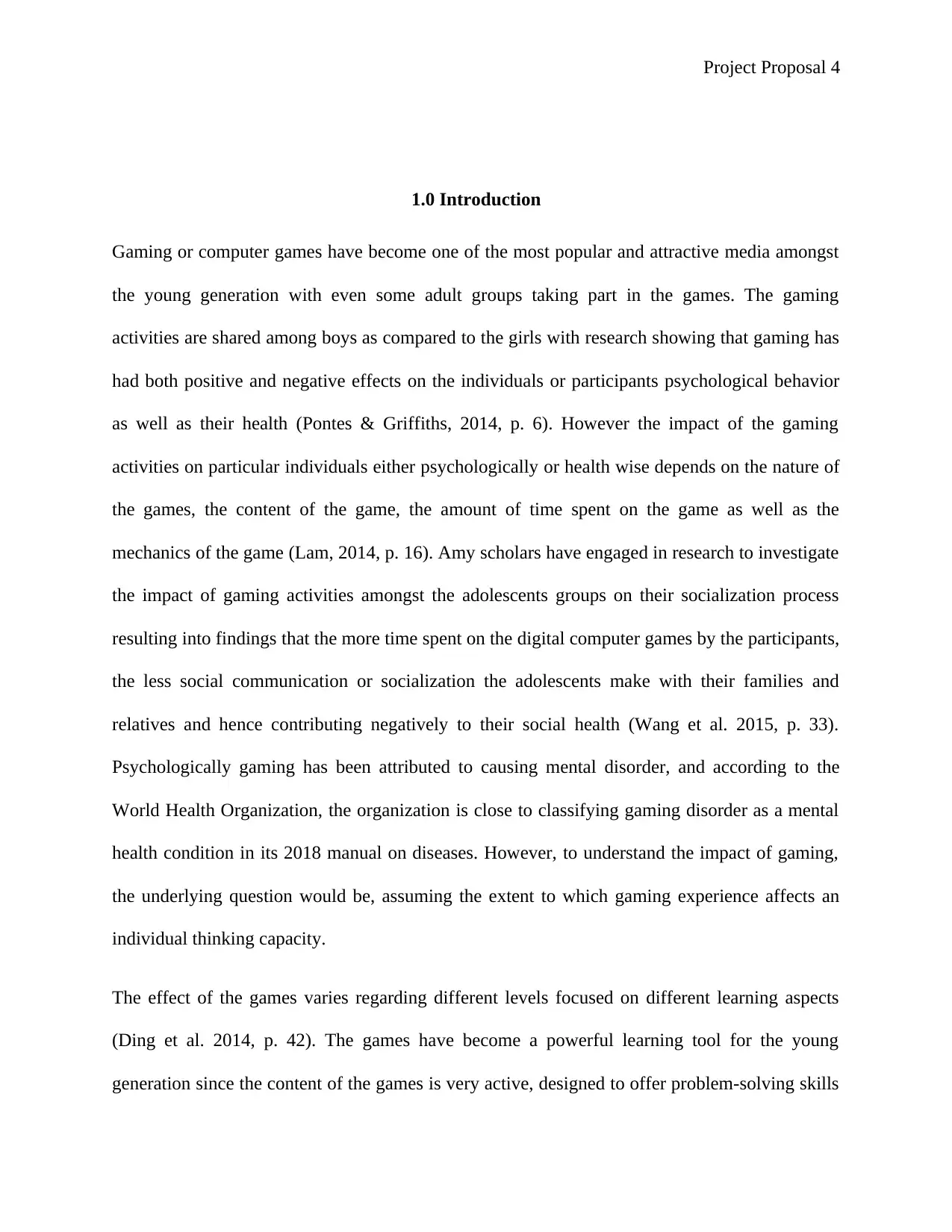
Project Proposal 4
1.0 Introduction
Gaming or computer games have become one of the most popular and attractive media amongst
the young generation with even some adult groups taking part in the games. The gaming
activities are shared among boys as compared to the girls with research showing that gaming has
had both positive and negative effects on the individuals or participants psychological behavior
as well as their health (Pontes & Griffiths, 2014, p. 6). However the impact of the gaming
activities on particular individuals either psychologically or health wise depends on the nature of
the games, the content of the game, the amount of time spent on the game as well as the
mechanics of the game (Lam, 2014, p. 16). Amy scholars have engaged in research to investigate
the impact of gaming activities amongst the adolescents groups on their socialization process
resulting into findings that the more time spent on the digital computer games by the participants,
the less social communication or socialization the adolescents make with their families and
relatives and hence contributing negatively to their social health (Wang et al. 2015, p. 33).
Psychologically gaming has been attributed to causing mental disorder, and according to the
World Health Organization, the organization is close to classifying gaming disorder as a mental
health condition in its 2018 manual on diseases. However, to understand the impact of gaming,
the underlying question would be, assuming the extent to which gaming experience affects an
individual thinking capacity.
The effect of the games varies regarding different levels focused on different learning aspects
(Ding et al. 2014, p. 42). The games have become a powerful learning tool for the young
generation since the content of the games is very active, designed to offer problem-solving skills
1.0 Introduction
Gaming or computer games have become one of the most popular and attractive media amongst
the young generation with even some adult groups taking part in the games. The gaming
activities are shared among boys as compared to the girls with research showing that gaming has
had both positive and negative effects on the individuals or participants psychological behavior
as well as their health (Pontes & Griffiths, 2014, p. 6). However the impact of the gaming
activities on particular individuals either psychologically or health wise depends on the nature of
the games, the content of the game, the amount of time spent on the game as well as the
mechanics of the game (Lam, 2014, p. 16). Amy scholars have engaged in research to investigate
the impact of gaming activities amongst the adolescents groups on their socialization process
resulting into findings that the more time spent on the digital computer games by the participants,
the less social communication or socialization the adolescents make with their families and
relatives and hence contributing negatively to their social health (Wang et al. 2015, p. 33).
Psychologically gaming has been attributed to causing mental disorder, and according to the
World Health Organization, the organization is close to classifying gaming disorder as a mental
health condition in its 2018 manual on diseases. However, to understand the impact of gaming,
the underlying question would be, assuming the extent to which gaming experience affects an
individual thinking capacity.
The effect of the games varies regarding different levels focused on different learning aspects
(Ding et al. 2014, p. 42). The games have become a powerful learning tool for the young
generation since the content of the games is very active, designed to offer problem-solving skills
Paraphrase This Document
Need a fresh take? Get an instant paraphrase of this document with our AI Paraphraser
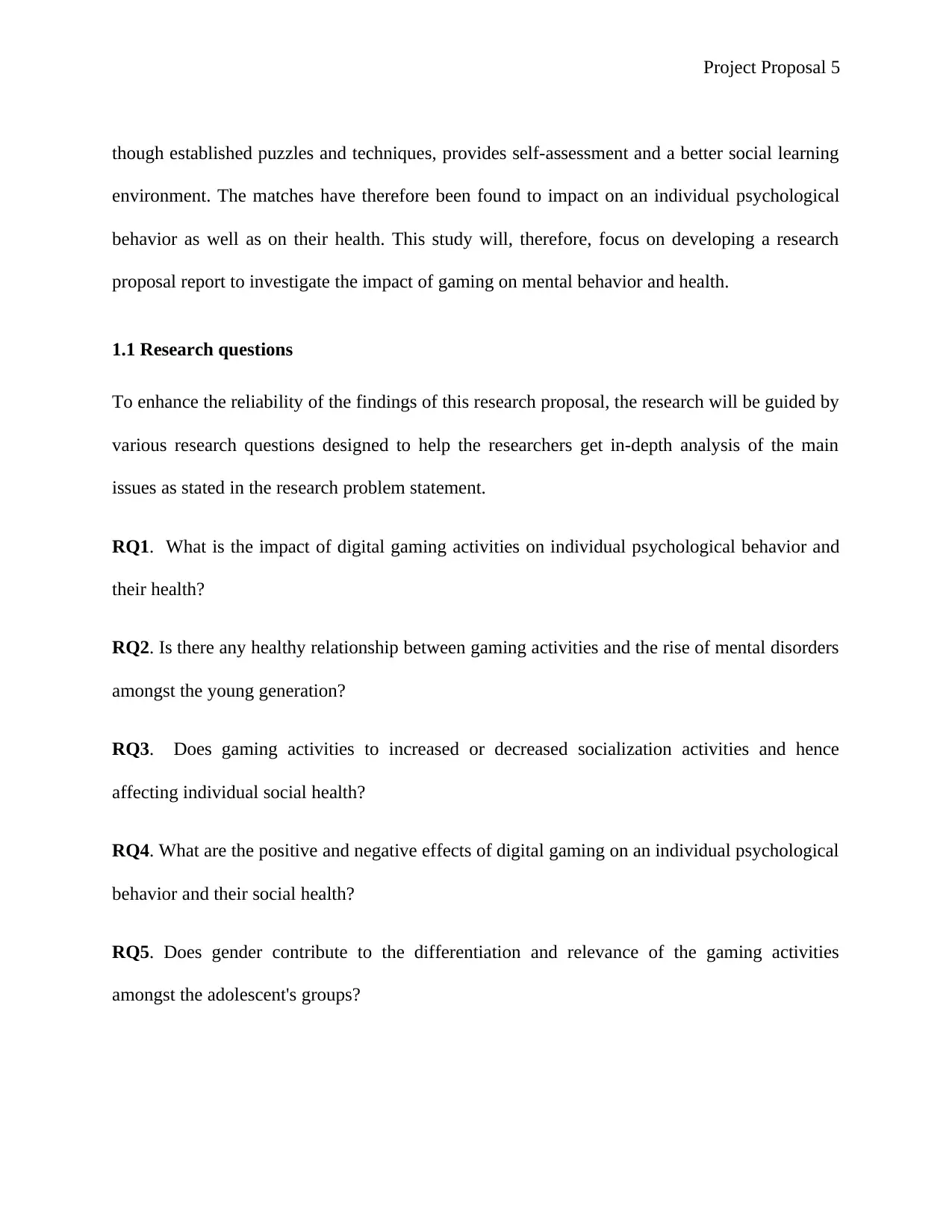
Project Proposal 5
though established puzzles and techniques, provides self-assessment and a better social learning
environment. The matches have therefore been found to impact on an individual psychological
behavior as well as on their health. This study will, therefore, focus on developing a research
proposal report to investigate the impact of gaming on mental behavior and health.
1.1 Research questions
To enhance the reliability of the findings of this research proposal, the research will be guided by
various research questions designed to help the researchers get in-depth analysis of the main
issues as stated in the research problem statement.
RQ1. What is the impact of digital gaming activities on individual psychological behavior and
their health?
RQ2. Is there any healthy relationship between gaming activities and the rise of mental disorders
amongst the young generation?
RQ3. Does gaming activities to increased or decreased socialization activities and hence
affecting individual social health?
RQ4. What are the positive and negative effects of digital gaming on an individual psychological
behavior and their social health?
RQ5. Does gender contribute to the differentiation and relevance of the gaming activities
amongst the adolescent's groups?
though established puzzles and techniques, provides self-assessment and a better social learning
environment. The matches have therefore been found to impact on an individual psychological
behavior as well as on their health. This study will, therefore, focus on developing a research
proposal report to investigate the impact of gaming on mental behavior and health.
1.1 Research questions
To enhance the reliability of the findings of this research proposal, the research will be guided by
various research questions designed to help the researchers get in-depth analysis of the main
issues as stated in the research problem statement.
RQ1. What is the impact of digital gaming activities on individual psychological behavior and
their health?
RQ2. Is there any healthy relationship between gaming activities and the rise of mental disorders
amongst the young generation?
RQ3. Does gaming activities to increased or decreased socialization activities and hence
affecting individual social health?
RQ4. What are the positive and negative effects of digital gaming on an individual psychological
behavior and their social health?
RQ5. Does gender contribute to the differentiation and relevance of the gaming activities
amongst the adolescent's groups?
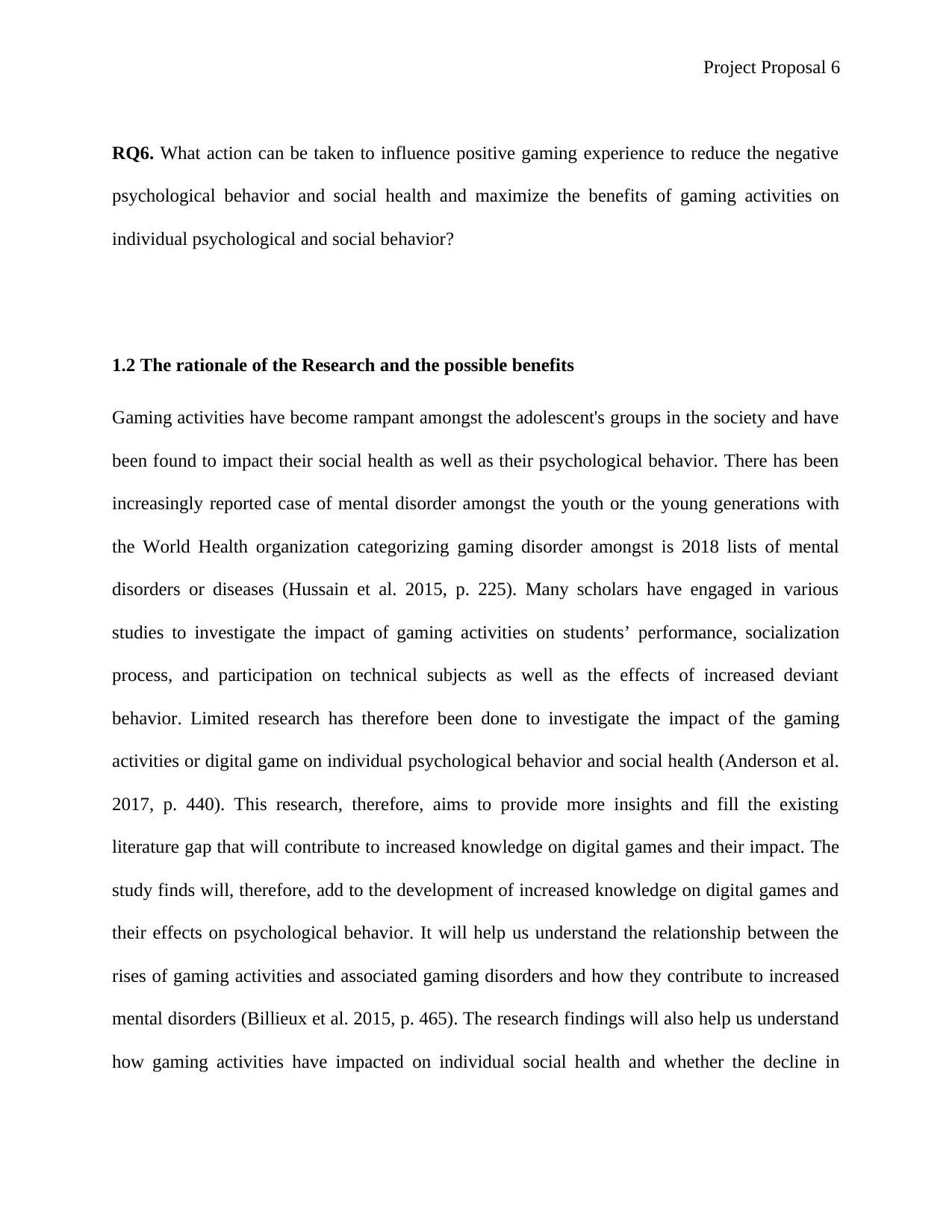
Project Proposal 6
RQ6. What action can be taken to influence positive gaming experience to reduce the negative
psychological behavior and social health and maximize the benefits of gaming activities on
individual psychological and social behavior?
1.2 The rationale of the Research and the possible benefits
Gaming activities have become rampant amongst the adolescent's groups in the society and have
been found to impact their social health as well as their psychological behavior. There has been
increasingly reported case of mental disorder amongst the youth or the young generations with
the World Health organization categorizing gaming disorder amongst is 2018 lists of mental
disorders or diseases (Hussain et al. 2015, p. 225). Many scholars have engaged in various
studies to investigate the impact of gaming activities on students’ performance, socialization
process, and participation on technical subjects as well as the effects of increased deviant
behavior. Limited research has therefore been done to investigate the impact of the gaming
activities or digital game on individual psychological behavior and social health (Anderson et al.
2017, p. 440). This research, therefore, aims to provide more insights and fill the existing
literature gap that will contribute to increased knowledge on digital games and their impact. The
study finds will, therefore, add to the development of increased knowledge on digital games and
their effects on psychological behavior. It will help us understand the relationship between the
rises of gaming activities and associated gaming disorders and how they contribute to increased
mental disorders (Billieux et al. 2015, p. 465). The research findings will also help us understand
how gaming activities have impacted on individual social health and whether the decline in
RQ6. What action can be taken to influence positive gaming experience to reduce the negative
psychological behavior and social health and maximize the benefits of gaming activities on
individual psychological and social behavior?
1.2 The rationale of the Research and the possible benefits
Gaming activities have become rampant amongst the adolescent's groups in the society and have
been found to impact their social health as well as their psychological behavior. There has been
increasingly reported case of mental disorder amongst the youth or the young generations with
the World Health organization categorizing gaming disorder amongst is 2018 lists of mental
disorders or diseases (Hussain et al. 2015, p. 225). Many scholars have engaged in various
studies to investigate the impact of gaming activities on students’ performance, socialization
process, and participation on technical subjects as well as the effects of increased deviant
behavior. Limited research has therefore been done to investigate the impact of the gaming
activities or digital game on individual psychological behavior and social health (Anderson et al.
2017, p. 440). This research, therefore, aims to provide more insights and fill the existing
literature gap that will contribute to increased knowledge on digital games and their impact. The
study finds will, therefore, add to the development of increased knowledge on digital games and
their effects on psychological behavior. It will help us understand the relationship between the
rises of gaming activities and associated gaming disorders and how they contribute to increased
mental disorders (Billieux et al. 2015, p. 465). The research findings will also help us understand
how gaming activities have impacted on individual social health and whether the decline in
⊘ This is a preview!⊘
Do you want full access?
Subscribe today to unlock all pages.

Trusted by 1+ million students worldwide
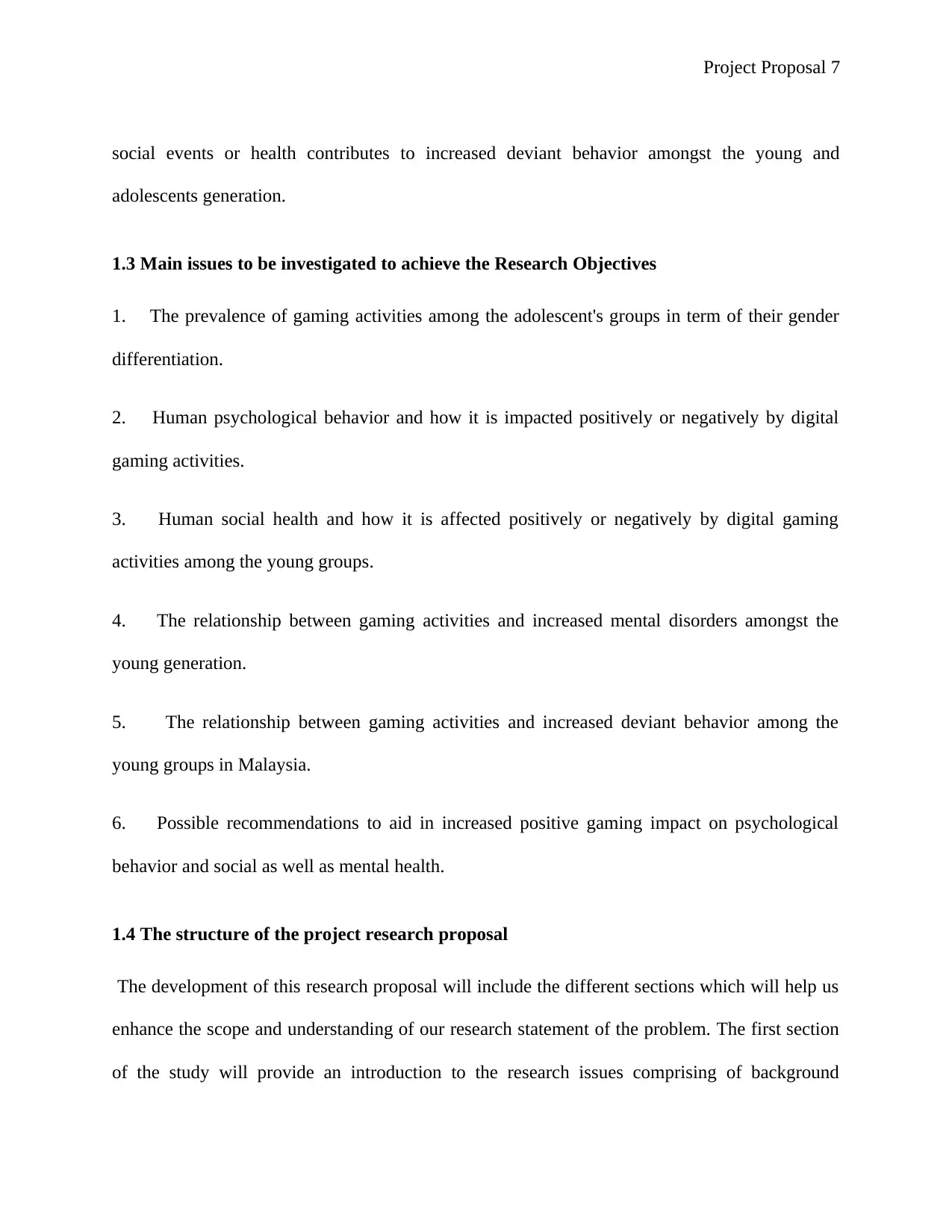
Project Proposal 7
social events or health contributes to increased deviant behavior amongst the young and
adolescents generation.
1.3 Main issues to be investigated to achieve the Research Objectives
1. The prevalence of gaming activities among the adolescent's groups in term of their gender
differentiation.
2. Human psychological behavior and how it is impacted positively or negatively by digital
gaming activities.
3. Human social health and how it is affected positively or negatively by digital gaming
activities among the young groups.
4. The relationship between gaming activities and increased mental disorders amongst the
young generation.
5. The relationship between gaming activities and increased deviant behavior among the
young groups in Malaysia.
6. Possible recommendations to aid in increased positive gaming impact on psychological
behavior and social as well as mental health.
1.4 The structure of the project research proposal
The development of this research proposal will include the different sections which will help us
enhance the scope and understanding of our research statement of the problem. The first section
of the study will provide an introduction to the research issues comprising of background
social events or health contributes to increased deviant behavior amongst the young and
adolescents generation.
1.3 Main issues to be investigated to achieve the Research Objectives
1. The prevalence of gaming activities among the adolescent's groups in term of their gender
differentiation.
2. Human psychological behavior and how it is impacted positively or negatively by digital
gaming activities.
3. Human social health and how it is affected positively or negatively by digital gaming
activities among the young groups.
4. The relationship between gaming activities and increased mental disorders amongst the
young generation.
5. The relationship between gaming activities and increased deviant behavior among the
young groups in Malaysia.
6. Possible recommendations to aid in increased positive gaming impact on psychological
behavior and social as well as mental health.
1.4 The structure of the project research proposal
The development of this research proposal will include the different sections which will help us
enhance the scope and understanding of our research statement of the problem. The first section
of the study will provide an introduction to the research issues comprising of background
Paraphrase This Document
Need a fresh take? Get an instant paraphrase of this document with our AI Paraphraser
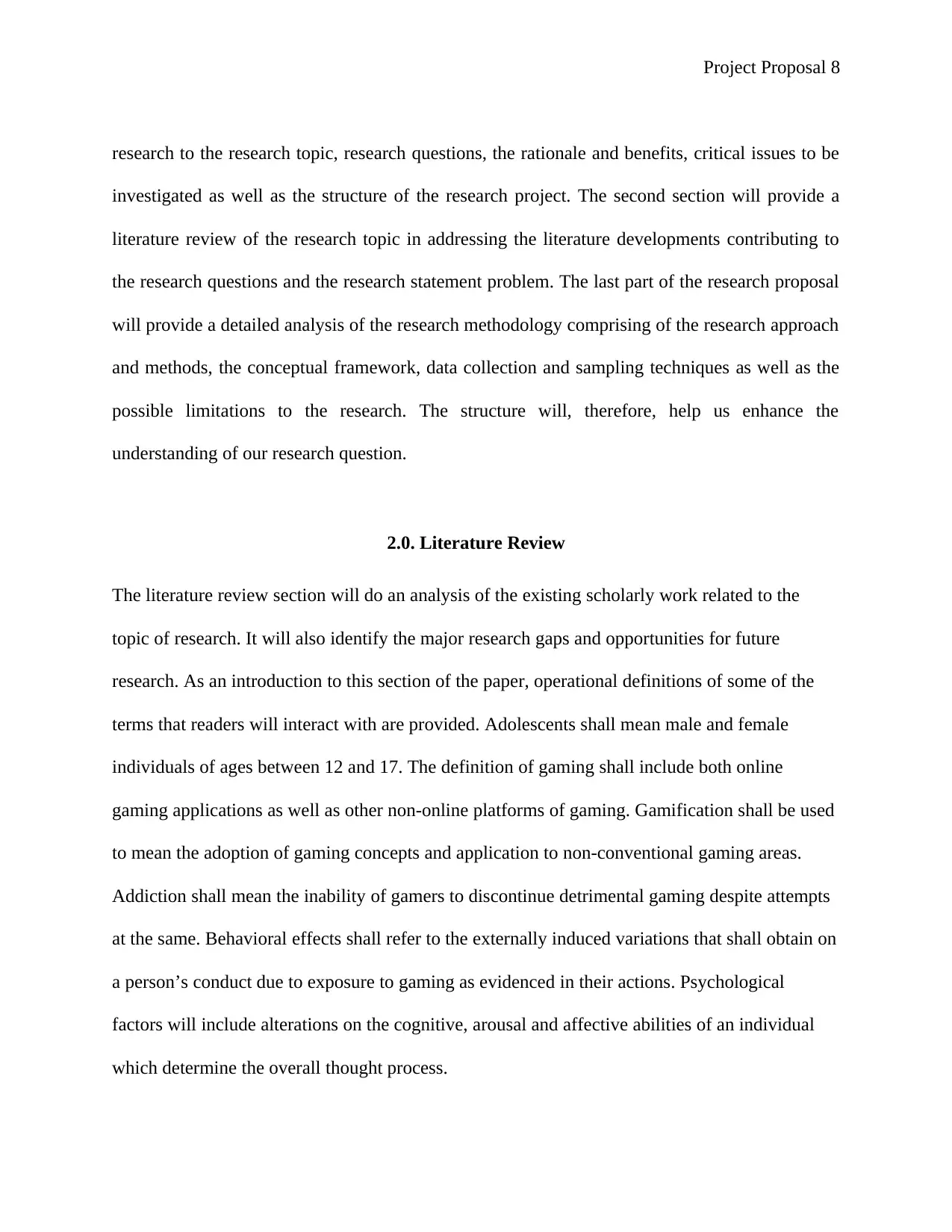
Project Proposal 8
research to the research topic, research questions, the rationale and benefits, critical issues to be
investigated as well as the structure of the research project. The second section will provide a
literature review of the research topic in addressing the literature developments contributing to
the research questions and the research statement problem. The last part of the research proposal
will provide a detailed analysis of the research methodology comprising of the research approach
and methods, the conceptual framework, data collection and sampling techniques as well as the
possible limitations to the research. The structure will, therefore, help us enhance the
understanding of our research question.
2.0. Literature Review
The literature review section will do an analysis of the existing scholarly work related to the
topic of research. It will also identify the major research gaps and opportunities for future
research. As an introduction to this section of the paper, operational definitions of some of the
terms that readers will interact with are provided. Adolescents shall mean male and female
individuals of ages between 12 and 17. The definition of gaming shall include both online
gaming applications as well as other non-online platforms of gaming. Gamification shall be used
to mean the adoption of gaming concepts and application to non-conventional gaming areas.
Addiction shall mean the inability of gamers to discontinue detrimental gaming despite attempts
at the same. Behavioral effects shall refer to the externally induced variations that shall obtain on
a person’s conduct due to exposure to gaming as evidenced in their actions. Psychological
factors will include alterations on the cognitive, arousal and affective abilities of an individual
which determine the overall thought process.
research to the research topic, research questions, the rationale and benefits, critical issues to be
investigated as well as the structure of the research project. The second section will provide a
literature review of the research topic in addressing the literature developments contributing to
the research questions and the research statement problem. The last part of the research proposal
will provide a detailed analysis of the research methodology comprising of the research approach
and methods, the conceptual framework, data collection and sampling techniques as well as the
possible limitations to the research. The structure will, therefore, help us enhance the
understanding of our research question.
2.0. Literature Review
The literature review section will do an analysis of the existing scholarly work related to the
topic of research. It will also identify the major research gaps and opportunities for future
research. As an introduction to this section of the paper, operational definitions of some of the
terms that readers will interact with are provided. Adolescents shall mean male and female
individuals of ages between 12 and 17. The definition of gaming shall include both online
gaming applications as well as other non-online platforms of gaming. Gamification shall be used
to mean the adoption of gaming concepts and application to non-conventional gaming areas.
Addiction shall mean the inability of gamers to discontinue detrimental gaming despite attempts
at the same. Behavioral effects shall refer to the externally induced variations that shall obtain on
a person’s conduct due to exposure to gaming as evidenced in their actions. Psychological
factors will include alterations on the cognitive, arousal and affective abilities of an individual
which determine the overall thought process.
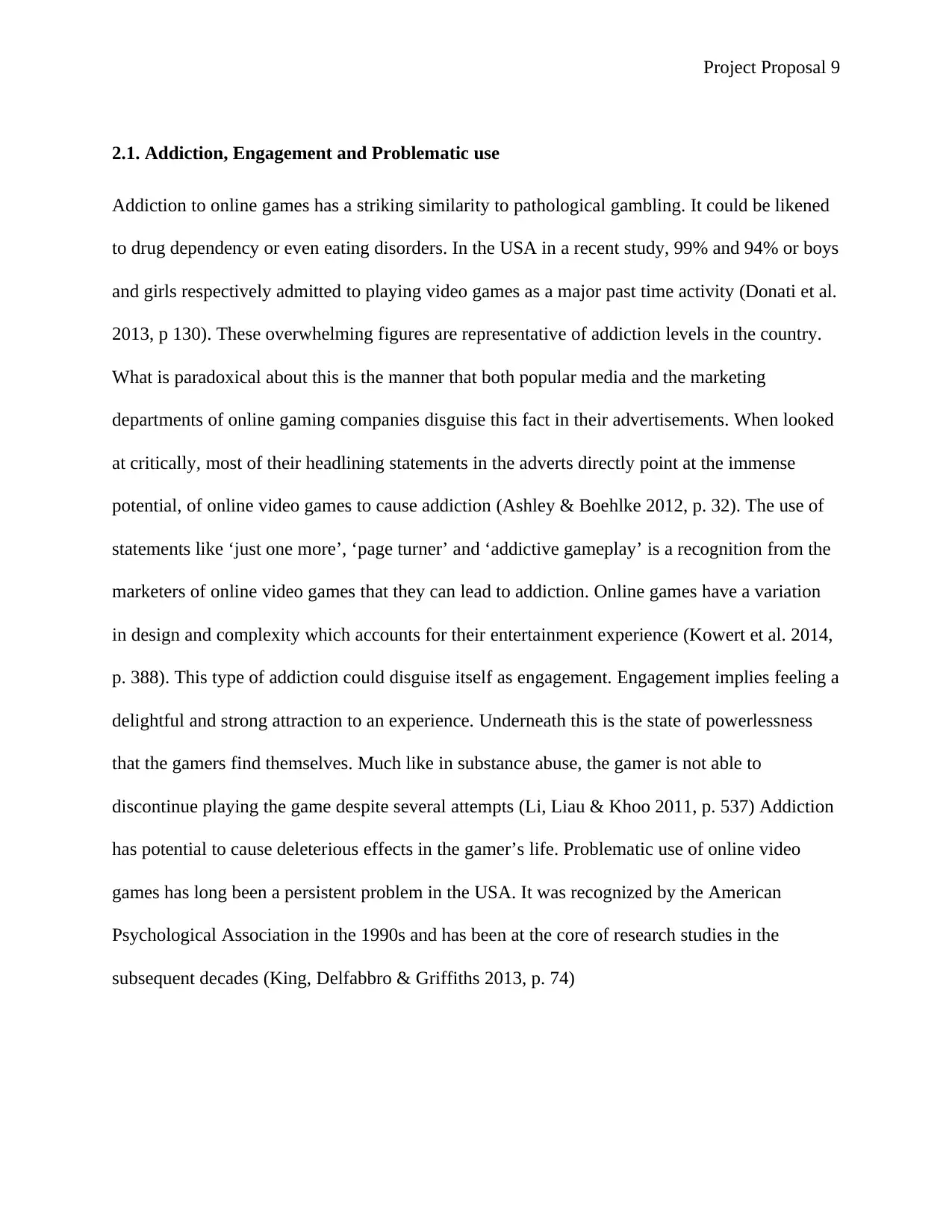
Project Proposal 9
2.1. Addiction, Engagement and Problematic use
Addiction to online games has a striking similarity to pathological gambling. It could be likened
to drug dependency or even eating disorders. In the USA in a recent study, 99% and 94% or boys
and girls respectively admitted to playing video games as a major past time activity (Donati et al.
2013, p 130). These overwhelming figures are representative of addiction levels in the country.
What is paradoxical about this is the manner that both popular media and the marketing
departments of online gaming companies disguise this fact in their advertisements. When looked
at critically, most of their headlining statements in the adverts directly point at the immense
potential, of online video games to cause addiction (Ashley & Boehlke 2012, p. 32). The use of
statements like ‘just one more’, ‘page turner’ and ‘addictive gameplay’ is a recognition from the
marketers of online video games that they can lead to addiction. Online games have a variation
in design and complexity which accounts for their entertainment experience (Kowert et al. 2014,
p. 388). This type of addiction could disguise itself as engagement. Engagement implies feeling a
delightful and strong attraction to an experience. Underneath this is the state of powerlessness
that the gamers find themselves. Much like in substance abuse, the gamer is not able to
discontinue playing the game despite several attempts (Li, Liau & Khoo 2011, p. 537) Addiction
has potential to cause deleterious effects in the gamer’s life. Problematic use of online video
games has long been a persistent problem in the USA. It was recognized by the American
Psychological Association in the 1990s and has been at the core of research studies in the
subsequent decades (King, Delfabbro & Griffiths 2013, p. 74)
2.1. Addiction, Engagement and Problematic use
Addiction to online games has a striking similarity to pathological gambling. It could be likened
to drug dependency or even eating disorders. In the USA in a recent study, 99% and 94% or boys
and girls respectively admitted to playing video games as a major past time activity (Donati et al.
2013, p 130). These overwhelming figures are representative of addiction levels in the country.
What is paradoxical about this is the manner that both popular media and the marketing
departments of online gaming companies disguise this fact in their advertisements. When looked
at critically, most of their headlining statements in the adverts directly point at the immense
potential, of online video games to cause addiction (Ashley & Boehlke 2012, p. 32). The use of
statements like ‘just one more’, ‘page turner’ and ‘addictive gameplay’ is a recognition from the
marketers of online video games that they can lead to addiction. Online games have a variation
in design and complexity which accounts for their entertainment experience (Kowert et al. 2014,
p. 388). This type of addiction could disguise itself as engagement. Engagement implies feeling a
delightful and strong attraction to an experience. Underneath this is the state of powerlessness
that the gamers find themselves. Much like in substance abuse, the gamer is not able to
discontinue playing the game despite several attempts (Li, Liau & Khoo 2011, p. 537) Addiction
has potential to cause deleterious effects in the gamer’s life. Problematic use of online video
games has long been a persistent problem in the USA. It was recognized by the American
Psychological Association in the 1990s and has been at the core of research studies in the
subsequent decades (King, Delfabbro & Griffiths 2013, p. 74)
⊘ This is a preview!⊘
Do you want full access?
Subscribe today to unlock all pages.

Trusted by 1+ million students worldwide
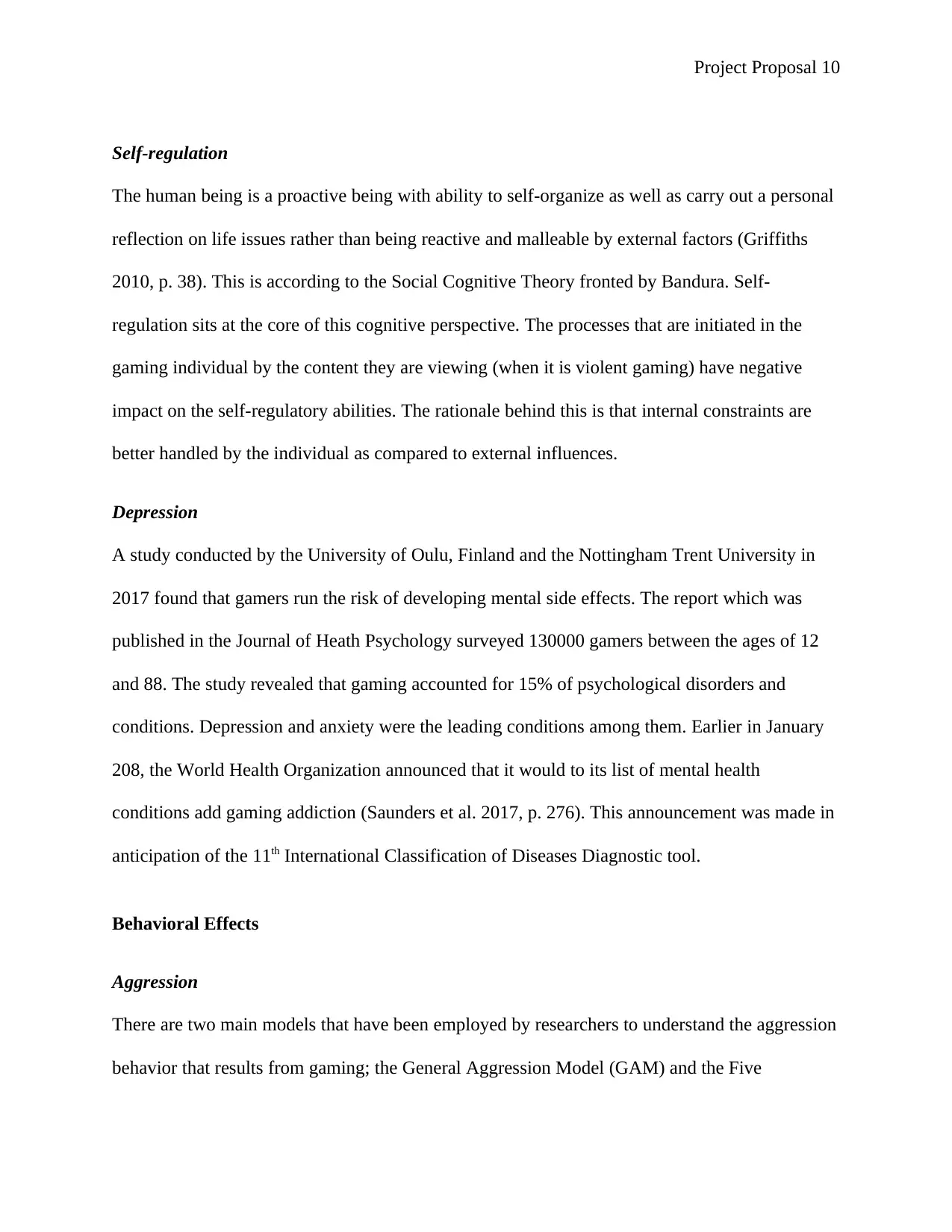
Project Proposal 10
Self-regulation
The human being is a proactive being with ability to self-organize as well as carry out a personal
reflection on life issues rather than being reactive and malleable by external factors (Griffiths
2010, p. 38). This is according to the Social Cognitive Theory fronted by Bandura. Self-
regulation sits at the core of this cognitive perspective. The processes that are initiated in the
gaming individual by the content they are viewing (when it is violent gaming) have negative
impact on the self-regulatory abilities. The rationale behind this is that internal constraints are
better handled by the individual as compared to external influences.
Depression
A study conducted by the University of Oulu, Finland and the Nottingham Trent University in
2017 found that gamers run the risk of developing mental side effects. The report which was
published in the Journal of Heath Psychology surveyed 130000 gamers between the ages of 12
and 88. The study revealed that gaming accounted for 15% of psychological disorders and
conditions. Depression and anxiety were the leading conditions among them. Earlier in January
208, the World Health Organization announced that it would to its list of mental health
conditions add gaming addiction (Saunders et al. 2017, p. 276). This announcement was made in
anticipation of the 11th International Classification of Diseases Diagnostic tool.
Behavioral Effects
Aggression
There are two main models that have been employed by researchers to understand the aggression
behavior that results from gaming; the General Aggression Model (GAM) and the Five
Self-regulation
The human being is a proactive being with ability to self-organize as well as carry out a personal
reflection on life issues rather than being reactive and malleable by external factors (Griffiths
2010, p. 38). This is according to the Social Cognitive Theory fronted by Bandura. Self-
regulation sits at the core of this cognitive perspective. The processes that are initiated in the
gaming individual by the content they are viewing (when it is violent gaming) have negative
impact on the self-regulatory abilities. The rationale behind this is that internal constraints are
better handled by the individual as compared to external influences.
Depression
A study conducted by the University of Oulu, Finland and the Nottingham Trent University in
2017 found that gamers run the risk of developing mental side effects. The report which was
published in the Journal of Heath Psychology surveyed 130000 gamers between the ages of 12
and 88. The study revealed that gaming accounted for 15% of psychological disorders and
conditions. Depression and anxiety were the leading conditions among them. Earlier in January
208, the World Health Organization announced that it would to its list of mental health
conditions add gaming addiction (Saunders et al. 2017, p. 276). This announcement was made in
anticipation of the 11th International Classification of Diseases Diagnostic tool.
Behavioral Effects
Aggression
There are two main models that have been employed by researchers to understand the aggression
behavior that results from gaming; the General Aggression Model (GAM) and the Five
Paraphrase This Document
Need a fresh take? Get an instant paraphrase of this document with our AI Paraphraser
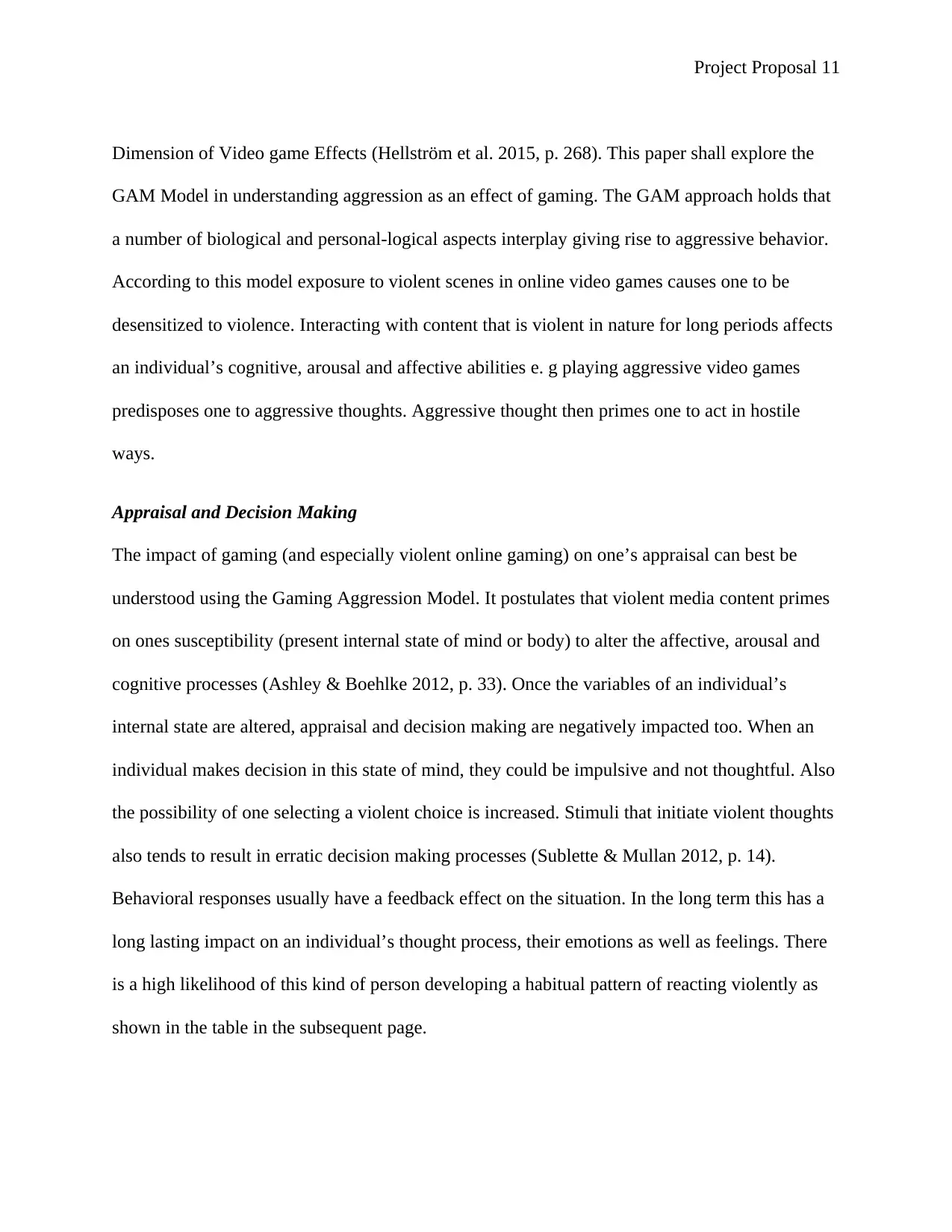
Project Proposal 11
Dimension of Video game Effects (Hellström et al. 2015, p. 268). This paper shall explore the
GAM Model in understanding aggression as an effect of gaming. The GAM approach holds that
a number of biological and personal-logical aspects interplay giving rise to aggressive behavior.
According to this model exposure to violent scenes in online video games causes one to be
desensitized to violence. Interacting with content that is violent in nature for long periods affects
an individual’s cognitive, arousal and affective abilities e. g playing aggressive video games
predisposes one to aggressive thoughts. Aggressive thought then primes one to act in hostile
ways.
Appraisal and Decision Making
The impact of gaming (and especially violent online gaming) on one’s appraisal can best be
understood using the Gaming Aggression Model. It postulates that violent media content primes
on ones susceptibility (present internal state of mind or body) to alter the affective, arousal and
cognitive processes (Ashley & Boehlke 2012, p. 33). Once the variables of an individual’s
internal state are altered, appraisal and decision making are negatively impacted too. When an
individual makes decision in this state of mind, they could be impulsive and not thoughtful. Also
the possibility of one selecting a violent choice is increased. Stimuli that initiate violent thoughts
also tends to result in erratic decision making processes (Sublette & Mullan 2012, p. 14).
Behavioral responses usually have a feedback effect on the situation. In the long term this has a
long lasting impact on an individual’s thought process, their emotions as well as feelings. There
is a high likelihood of this kind of person developing a habitual pattern of reacting violently as
shown in the table in the subsequent page.
Dimension of Video game Effects (Hellström et al. 2015, p. 268). This paper shall explore the
GAM Model in understanding aggression as an effect of gaming. The GAM approach holds that
a number of biological and personal-logical aspects interplay giving rise to aggressive behavior.
According to this model exposure to violent scenes in online video games causes one to be
desensitized to violence. Interacting with content that is violent in nature for long periods affects
an individual’s cognitive, arousal and affective abilities e. g playing aggressive video games
predisposes one to aggressive thoughts. Aggressive thought then primes one to act in hostile
ways.
Appraisal and Decision Making
The impact of gaming (and especially violent online gaming) on one’s appraisal can best be
understood using the Gaming Aggression Model. It postulates that violent media content primes
on ones susceptibility (present internal state of mind or body) to alter the affective, arousal and
cognitive processes (Ashley & Boehlke 2012, p. 33). Once the variables of an individual’s
internal state are altered, appraisal and decision making are negatively impacted too. When an
individual makes decision in this state of mind, they could be impulsive and not thoughtful. Also
the possibility of one selecting a violent choice is increased. Stimuli that initiate violent thoughts
also tends to result in erratic decision making processes (Sublette & Mullan 2012, p. 14).
Behavioral responses usually have a feedback effect on the situation. In the long term this has a
long lasting impact on an individual’s thought process, their emotions as well as feelings. There
is a high likelihood of this kind of person developing a habitual pattern of reacting violently as
shown in the table in the subsequent page.
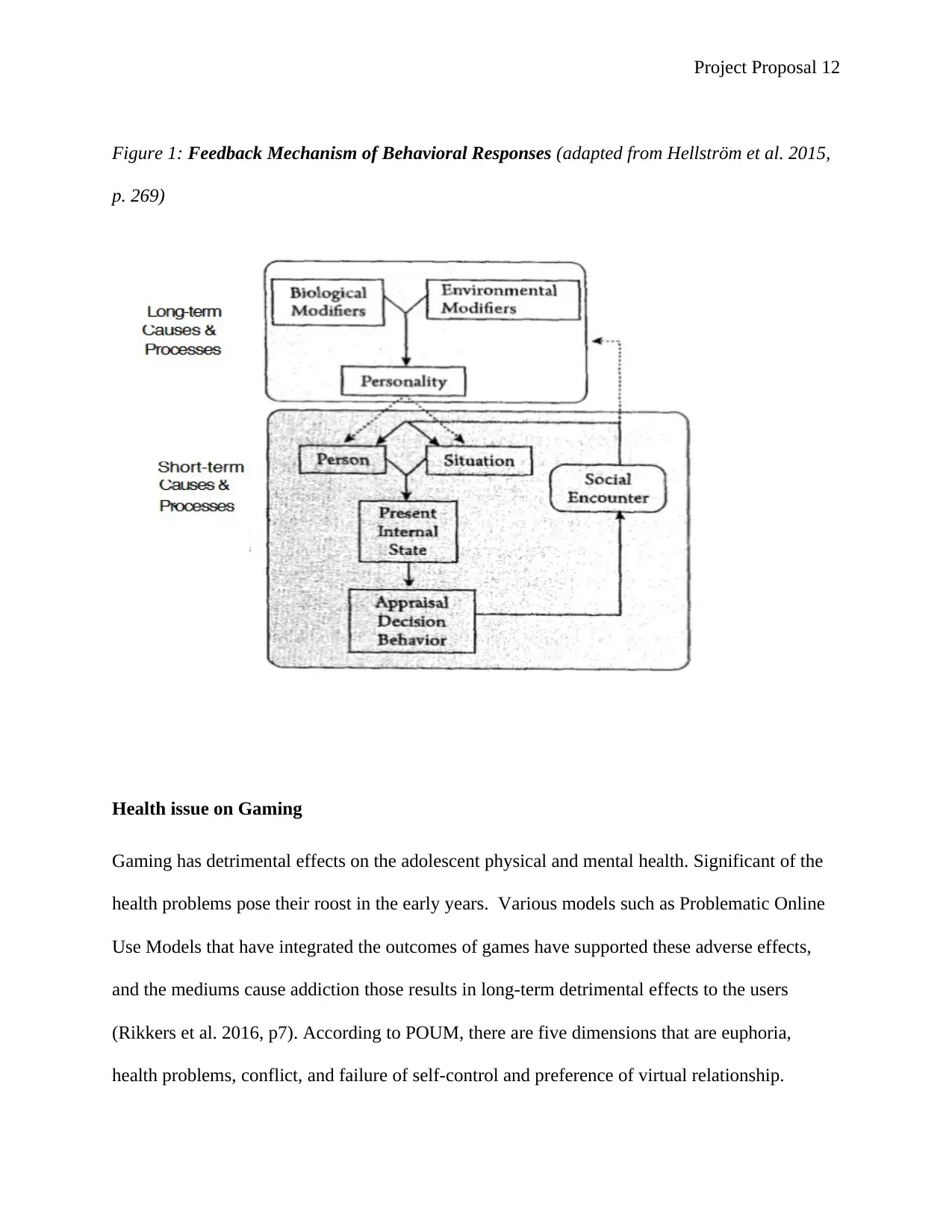
Project Proposal 12
Figure 1: Feedback Mechanism of Behavioral Responses (adapted from Hellström et al. 2015,
p. 269)
Health issue on Gaming
Gaming has detrimental effects on the adolescent physical and mental health. Significant of the
health problems pose their roost in the early years. Various models such as Problematic Online
Use Models that have integrated the outcomes of games have supported these adverse effects,
and the mediums cause addiction those results in long-term detrimental effects to the users
(Rikkers et al. 2016, p7). According to POUM, there are five dimensions that are euphoria,
health problems, conflict, and failure of self-control and preference of virtual relationship.
Figure 1: Feedback Mechanism of Behavioral Responses (adapted from Hellström et al. 2015,
p. 269)
Health issue on Gaming
Gaming has detrimental effects on the adolescent physical and mental health. Significant of the
health problems pose their roost in the early years. Various models such as Problematic Online
Use Models that have integrated the outcomes of games have supported these adverse effects,
and the mediums cause addiction those results in long-term detrimental effects to the users
(Rikkers et al. 2016, p7). According to POUM, there are five dimensions that are euphoria,
health problems, conflict, and failure of self-control and preference of virtual relationship.
⊘ This is a preview!⊘
Do you want full access?
Subscribe today to unlock all pages.

Trusted by 1+ million students worldwide
1 out of 30
Related Documents
Your All-in-One AI-Powered Toolkit for Academic Success.
+13062052269
info@desklib.com
Available 24*7 on WhatsApp / Email
![[object Object]](/_next/static/media/star-bottom.7253800d.svg)
Unlock your academic potential
Copyright © 2020–2025 A2Z Services. All Rights Reserved. Developed and managed by ZUCOL.





